GetStudySolution
Getstudysolution is an online educational platform that allows students to access quality educational services and study materials at no cost.
NCERT Solutions for class 7 Science chapter 13 – Motion and Time
Back Exercise
1. Classify the following as motion along a straight line, circular or oscillatory motion:
(i) Motion of your hands while running.
(ii) Motion of a horse pulling a cart on a straight road.
(iii) Motion of a child in a merry-go-round.
(iv) Motion of a child on a see-saw.
(v) Motion of the hammer of an electric bell.
(vi) Motion of a train on a straight bridge.
Solution:
i) oscillatory
ii) Motion along a straight line
iii) Circular motion
iv) Oscillatory motion
v) Oscillatory motion
vi) Motion along a straight line.
2. Which of the following are not correct?
(i) The basic unit of time is second.
(ii) Every object moves with a constant speed.
(iii) Distances between two cities are measured in kilometres.
(iv) The time period of a given pendulum is constant.
(v) The speed of a train is expressed in m/h.
Solution:
Incorrect statements are:
(ii) Every object moves with a constant speed.
(iv) The time period of a given pendulum is constant.
(v) The speed of a train is expressed in m/h.
3. A simple pendulum takes 32 s to complete 20 oscillations. What is the time period of the pendulum?
Solution:
Number of oscillations = 20
Total time taken to complete 20 oscillations = 32 s
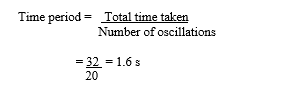
4. The distance between two stations is 240 km. A train takes 4 hours to cover this distance. Calculate the speed of the train.
Solution:
Distance between two stations = 240 kms
Total time take = 4 hrs/240 minutes

= 60 km/h
5. The odometer of a car reads 57321.0 km when the clock shows the time 08:30 AM. What is the distance moved by the car, if at 08:50 AM, the odometer reading has changed to 57336.0 km? Calculate the speed of the car in km/min during this time. Express the speed in km/h also.
Solution:
Initial reading of the odometer = 57321.0
Final reading of the odometer = 57336.0
Distance covered by the car = Final reading of the odometer – Initial reading of the odometer
= 57336.0 – 57321.0 = 15 kms
Starting time of car is 8:30 and it stops at 8: 50
Hence, time taken by car = 20 mins
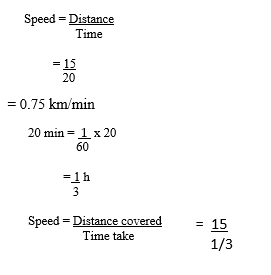
= 45 km/h
6. Salma takes 15 minutes from her house to reach her school on a bicycle. If the bicycle has a speed of 2 m/s, calculate the distance between her house and the school.
Solution:
Time taken by Salma to reach her school by bicycle = 15 mins= 15 x 60 = 90 s
Speed of Salma’s bicycle= 2m/s

Distance covered = speed x time taken
= 2 x 900 = 1800 m
1000m = 1 km

= 1.8 kms
7. Show the shape of the distance-time graph for the motion in the following cases:
(i) A car moving with a constant speed.
(ii) A car parked on a side road.
Solution:
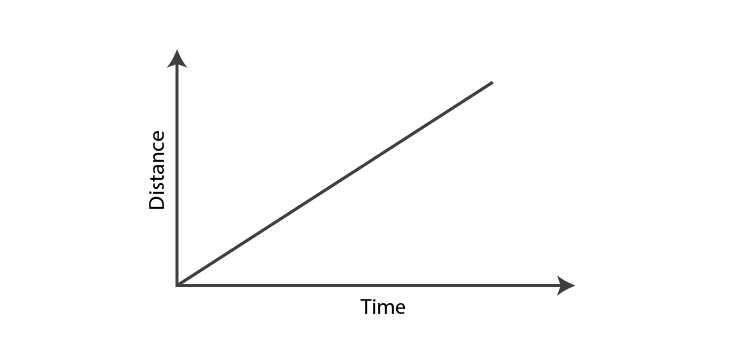
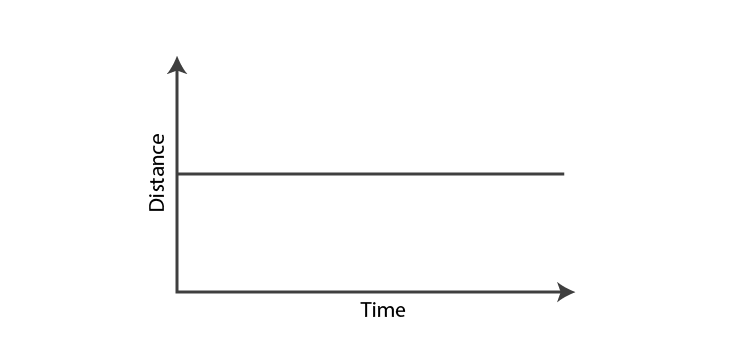
8. Which of the following relations is correct?
(i) Speed = Distance × Time
(ii) Speed = Distance/Time
(iii) Speed = Time/Distance
(iv) Speed = 1/Distance x Time
Solution:
Answer is (ii) Speed = Distance/Time
9. The basic unit of speed is:
(i) km/min
(ii) m/min
(iii) km/h
(iv) m/s
Solution:
Answer is (iv) m/s
10. A car moves with a speed of 40 km/h for 15 minutes and then with a speed of 60 km/h for the next 15 minutes. The total distance covered by the car is:
(i) 100 km (ii) 25 km (iii) 15 km (iv) 10 km
Solution:
The answer is (ii) 25 km
Calculation:
When the speed of the car is 40 km/h
Time taken = 15 min = 15/60 = 0.25 h

Distance covered d1 = speed x time taken
= 40 x 0.25 = 10 kms
When the speed of the Car is 60 km/ h

Distance covered d2 = speed x time taken
= 60 x 0.25= 15 kms
Total distance covered by the car = d1 + d2
= 10 + 15
= 25 kms
11. Suppose the two photographs, shown in Fig. 13.1 and Fig. 13.2, had been taken at an interval of 10 seconds. If a distance of 100 metres is shown by 1 cm in these photographs, calculate the speed of the fastest car.
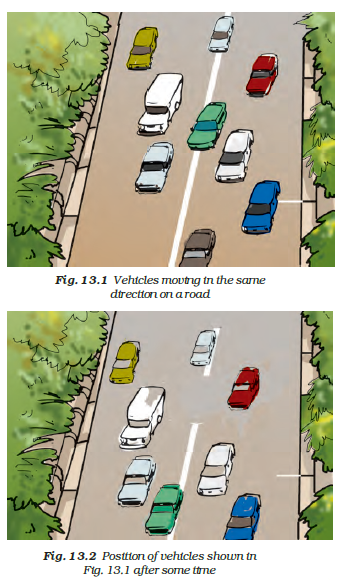
Solution:
The distance covered by the blue car (as evident from the photograph) from one horizontal white strip to another, which is measured by scale is 1.2 cm.
It is given that 1 cm is equivalent to 100 m.
Therefore, 1.2 cm is equivalent to 120 m.
Distance travelled by the car = 120 m
Time taken to cover this distance = Time interval between the two photographs = 10 s

= 120/10
= 12 m/s
12. Fig. 13.15 shows the distance-time graph for the motion of two vehicles A and B. Which one of them is moving faster?

Solution:
Vehicle A is moving faster than vehicle B.
13. Which of the following distance-time graphs shows a truck moving with speed which is not constant?
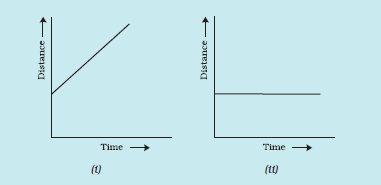
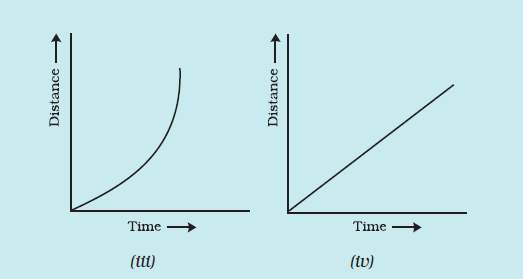
Solution:
Answer is iii)